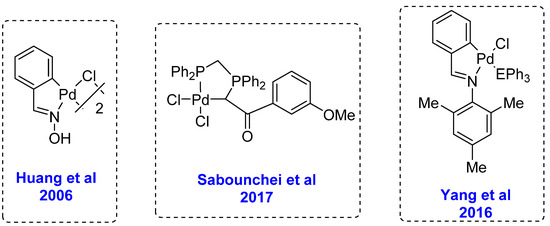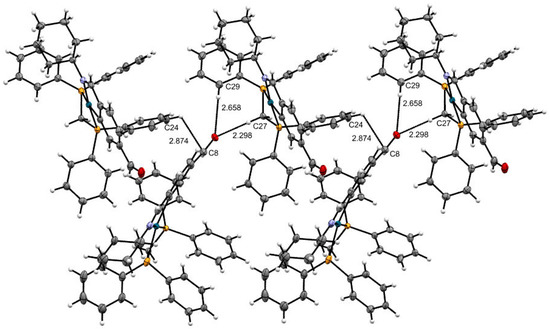Abstract
The reaction between a cholro-bridged dinuclear compound (a, b) and a diphosphine (dppm) ligand in a molar ratio of 1:2 yielded a mononuclear compound [{Pd[R-C6H3C(H)=NCy]{Ph2PCH2PPh2-P,P}][PF6] {R = 3-CHO (1a), 4-CHO (1b)}. The compounds were characterized using IR, 1H, and 31P–{1H} NMR spectroscopy, and compound 1b was identified using X-ray diffraction.
1. Introduction
One of the classic ways to activate C–H bonds in hetero-substituted organic compounds is through the cyclometallation reaction, which is a well-known procedure [1]. The first cyclometallated compounds were discovered in the mid–1960s [2], and since then, this reaction has received a lot of attention because of the many applications of metallacycles, such as organic synthesis, catalysis, metallomesogen design, asymmetric synthesis, racemic ligand resolution, C–H bond activation, the synthesis and reactivity of organometallic compounds with biologically active ligands, and medical chemistry. In recent years, phosphine ligands have received a lot of attention [3,4,5], such as bis[diphenylphosphino]methane (dppm) ligands, which are widely employed in transition metal chemistry as chelating and bridging coordination modes ligands [6]. However, in square planar metal complexes with a d8 configuration, the tendency for chelation of diphosphine ligands is very strong [7,8,9], hence several mononuclear dppm–type compounds have shown interest in homogeneous catalysis [10,11,12,13]. These bidentate diphosphine ligands are useful in metal-catalyzed processes. Over the last 30 years, metal–catalyzed cross-coupling reactions have grown in prominence, particularly as convenient procedures for forming C–C bonds [14,15]. Palladium-catalyzed reactions have piqued curiosity [16,17]. The Suzuki–Miyaura reaction, which is catalyzed by palladium, is one of the most important ways for the formation of C–C bonds under very mild experimental conditions and is particularly useful for the creation of biaryls [18]. In the Suzuki cross-coupling reaction, both nitrogen-based ligands (amines or imines) and bulky phosphines (phosphorus ylides) have been successfully described (Figure 1) [19]. New catalysts are needed for current technologies that are low-cost, easily available, moisture- and air-stable, and most critically, extremely effective at low catalyst loading [20,21].

Figure 1.
Palladacycle catalysts in activity [20,21,22].
2. Result and Discussion
The mononuclear compounds were obtained by treating the halide-bridged dinuclear compound a and b with bis(diphenylphosphino)methane (dppm) in the existence of NH4PF6 in a 1:2 molar ratio (Scheme 1). The IR spectra revealed a shift in the C=N stretch’s direction. Compared to the free Schiff base, the lower wavenumber nitrogen coordination of the C=N ligand group in the 1H NMR spectra, the HC=O resonance shows a singlet signal at δ 9.87 for 1a and δ 9.53 for 1b, and the HC=N resonance appears as a doublet ca. δ 8.43 by connecting to only the 31P nucleus trans to nitrogen for both compounds. The proton H5, coupled to both phosphorus nuclei, was assigned a doublet at δ 6.90 for 1a [4J(H5P) = 7.9 Hz]and δ 6.80 for 1b [4J(H5P) = 6.4 Hz]. In the 31P–{1H} NMR spectra, two doublets were seen for the two non-equivalent phosphoruses. The doublets were assigned based on the idea that a ligand with more trans influence causes the resonance of the phosphorus atoms trans to it to shift to a lower frequency [22].

Scheme 1.
dppm, acetone, r.t.
The crystal structure of 1b (Figure 2) includes a mononuclear molecule and a hexafluorophosphate anion. A (N1) from the imine group, (C1) an ortho carbon atom from the phenyl ring, and (P1,P2) two phosphorus atoms from a chelating dppm form the coordination sphere surrounding the palladium atom. At a palladium, the sums of angles are nearly 360°, with the distortions being more visible at the slightly reduced “bite” angles C1–Pd1–N1 [81.02]°, resulting from chelation. The bond angles P(1)–Pd(1)–P(2) are forced to 70.15 by the demands of the four-membered chelate ring of phosphine. The Pd1–N1 bond length is 2.097 Å, and the Pd1–C1 bond length is 2.025 Å. The Pd–P distance trans to carbon, Pd(1)–P(2), and trans to nitrogen, Pd(1)–P(1), [2.463(13) Å versus 2.248(11) Å] clearly indicate the contrasting influence of the phenyl carbon and imine nitrogen atoms (Table 1).

Figure 2.
Crystal structure of compound 1b. Solvent molecules and hydrogen atoms have been omitted for clarity.

Table 1.
Bond lengths are given in [Å] and angles in [◦] of 1b.
The hydrogen bonding between the adjacent molecules in the C8···H18−C18aryl and O1···H−C intermolecular contact causes weak interactions, as shown in Figure 3. Weak C8···H24; 2.874 Å, C8−C24; 3.191 Å, O1···H27a; 2.298 Å and O1···H29; 2.658 Å (Table 2) connect the crystal structure 1b, resulting in a bifurcated hydrogen bond that extends along the crystallographic direction. Symmetry code#1/2 + x, 1.5 − y, −1/2 + z.

Figure 3.
The packing view in complex 1b shows intermolecular interaction (C−H···Caryl) and (C−H···O) the PF6 ions have been omitted for clarity.

Table 2.
C–H···Caryl interactions [Å, °] of 1b.
Table S1 shows Crystal data and structure refinement for 1b.
3. Experimental Part
The synthesis of [Pd{3-(COH)C6H3C(H)=NCy}(µ-Cl)]2 (a) and [Pd{4-(COH)C6H3C(H)=NCy}(µ-Cl)]2 (b) were reported previously by our group [23].
Preparation of [Pd{R-C6H3C(H)=NCy]{PPh2CH2PPh2}[PF6] {R= 3-CHO, 4-CHO}. (1a, 1b)
To a solution of a or b (50 mg, 0.070 mmol), dppm (53.8 mg, 0.0140 mmol), in acetone 15 mL was added. The mixture was mixed at room temperature for 2 h, following which ammonium hexafluorophosphate (23 mg, 0.0140 mmol) was added, the solution was stirred for another 1 h, water ca. 20 mL was added dropwise, and the mixture was stirred for another 2 h. A precipitate was produced, which was then filtered, washed with water, and dried in vacuo. The required compound was recrystallized as pale-yellow microcrystals in CH2Cl2/n-hexane. 1a: Yield 73 %, IR = 1693 cm−1 (C=O), 1617 cm−1 (C=N), 1H NMR (400 MHz, CDCl3) δ 9.87 (s, 1H, HC=O), 8.42 (d, 4J = 6.9 Hz, 1H, Hi), 7.95 (s, 1H, H2), 7.75–7.37 (m, 20H, PPh2), 6.90 (d, 4J = 8.0 Hz, 1H, H5), 4.30 (t, 2J = 9.8 Hz, 2H, CH2), 3.37 (m, 1H, N-CH-Cy), 0.6 5–2.0 (m, 20H, Cy) (Figure S1). 31P NMR (CDCl3, 162 MHz)–4.8 (d, J = 63.9 Hz), −28.2 (d, J = 63.9 Hz), −141.7 (h, PF6) (Figure S2).
1b: Yield 82 %, IR = 1692 cm−1 (C=O), 1624 cm−1 (C=N), 1H NMR (400 MHz, CDCl3) δ 9.53 (s, 1H, HC=O), 8.43 (d, 4J = 7.3 Hz, 1H, Hi), 7.86 –7.32 (m, 20H, PPh2), 7.11 (t, 3J = 8.4 Hz, 1H, H3), 6.80 (d, 4J = 6.4 Hz, 1H, H5), 4.30 (dd, 2J = 11.3, 8.2 Hz, 2H, CH2), 3.38 (m, 1H, N-CH-Cy), 0.6–2.30 (m, 20H, Cy) (Figure S1). 31P NMR (CDCl3, 162 MHz)–4.8 (d, J = 64.5 Hz), −28.2 (d, J = 64.5 Hz), −141.5 (h, PF6).
Supplementary Materials
The following supporting information can be downloaded at https://www.mdpi.com/article/10.3390/ecsoc-26-13563/s1. Figure S1: 1H NMR of compounds 1a and 1b in CDCl3; Figure S2: 31P {1H}NMR of compound 1a in CDCl3; Table S1: Crystal data and structure refinement for 1b.
Author Contributions
Formal analysis, B.A.J.; Methodology, B.A.J.; Writing original draft, B.A.J.; Review and editing, J.M.V. and J.M.O. All authors have read and agreed to the published version of the manuscript.
Funding
This research was funded by the Xunta de Galicia. GRC2019/14.
Institutional Review Board Statement
Not applicable.
Informed Consent Statement
Not applicable.
Data Availability Statement
Not applicable.
Acknowledgments
We would like to thank the Xunta de Galicia (Galicia, Spain) and the Competitive Reference Groups GRC2019/14 for their financial support.
Conflicts of Interest
The authors declare no conflict of interest.
References
- Albrecht, M. Cyclometalation using d-block transition metals: Fundamental aspects and recent trends. Chem. Rev. 2010, 110, 576–623. [Google Scholar] [CrossRef] [PubMed]
- Kleiman, J.P.; Dubeck, M. The preparation of cyclopentadienyl [o-(phenylazo) phenyl] nickel. J. Am. Chem. Soc. 1963, 85, 1544–1545. [Google Scholar] [CrossRef]
- Chitnis, S.S.; Burford, N. Phosphine complexes of lone pair bearing Lewis acceptors. Dalton Trans. 2015, 44, 17–29. [Google Scholar] [CrossRef]
- Hu, Z.; Wei, X.J.; Handelmann, J.; Seitz, A.K.; Rodstein, I.; Gessner, V.H.; Gooßen, L.J. Coupling of Reformatsky Reagents with Aryl Chlorides Enabled by Ylide-Functionalized Phosphine Ligands. Angew. Chem. Int. Ed. 2021, 60, 6778–6783. [Google Scholar] [CrossRef] [PubMed]
- Horky, F.; Cisarova, I.; Stepnicka, P. Synthesis, Reactivity, and Coordination of Semihomologous dppf Congeners Bearing Primary Phosphine and Primary Phosphine Oxide Groups. Organometallics 2021, 40, 427–441. [Google Scholar] [CrossRef]
- Chaudret, B.; Delavaux, B.; Poilblanc, R. Bisdiphenylphosphinomethane in dinuclear complexes. Coord. Chem. Rev. 1988, 86, 191–243. [Google Scholar] [CrossRef]
- Yilmaz, V.T.; Icsel, C.; Aygun, M.; Erkisa, M.; Ulukaya, E. Pd(II) and Pt(II) saccharinate complexes of bis (diphenylphosphino) propane/butane: Synthesis, structure, antiproliferative activity and mechanism of action. Eur. J. Med. Chem. 2018, 158, 534–547. [Google Scholar] [CrossRef]
- Odachowski, M.; Marschner, C.; Blom, B. A review on 1, 1-bis (diphenylphosphino) methane bridged homo-and heterobimetallic complexes for anticancer applications: Synthesis, structure, and cytotoxicity. Eur. J. Med. Chem. 2020, 204, 112613. [Google Scholar] [CrossRef]
- Naghipour, A.; Sayadi, M.; Sedghi, A.; Sabounchei, S.J.; Babaee, H.; Notash, B. A comparative study of palladium-based coordination compounds with bidentate (N, N, P, P and P, O) ligands; Design, synthesis, X-ray structural, catalytic activity and DFT studies. Inorg. Chim. Acta 2021, 515, 120039. [Google Scholar] [CrossRef]
- Mansell, S.M. Catalytic applications of small bite-angle diphosphorus ligands with single-atom linkers. Dalton Trans. 2017, 46, 15157–15174. [Google Scholar] [CrossRef] [PubMed]
- Dowson, G.R.; Haddow, M.F.; Lee, J.; Wingad, R.L.; Wass, D.F. Catalytic conversion of ethanol into an advanced biofuel: Unprecedented selectivity for n-butanol. Angew. Chem. Int. Ed. 2013, 52, 9005–9008. [Google Scholar] [CrossRef] [PubMed]
- Prades, A.; Fernández, M.; Pike, S.D.; Willis, M.C.; Weller, A.S. Well-Defined and Robust Rhodium Catalysts for the Hydroacylation of Terminal and Internal Alkenes. Angew. Chem. Int. Ed. 2015, 54, 8520–8524. [Google Scholar] [CrossRef] [PubMed]
- Gao, M.; Willis, M.C. Enantioselective Three-Component Assembly of β′-Aryl Enones Using a Rhodium-Catalyzed Alkyne Hydroacylation/Aryl Boronic Acid Conjugate Addition Sequence. Org. Lett. 2017, 19, 2734–2737. [Google Scholar] [CrossRef] [PubMed]
- Sabounchei, S.J.; Ahmadi, M. An efficient protocol for copper-and amine-free Sonogashira reactions catalyzed by mononuclear palladacycle complexes containing bidentate phosphine ligands. Catal. Commun. 2013, 37, 114–121. [Google Scholar] [CrossRef]
- Sabounchei, S.J.; Hosseinzadeh, M. C(sp2)–C(sp2) cross-coupling reaction catalyzed by a palladacycle phosphine complex: A simple and sustainable protocol in aqueous media. J. Chem. Sci. 2015, 127, 1919–1926. [Google Scholar] [CrossRef]
- Ghorbani-Choghamarani, A.; Naghipour, A.; Babaee, H.; Notash, B. Synthesis, crystal structure study and high efficient catalytic activity of di-μbromo-trans–dibromobis [(benzyl)(4-methylphenyl)(phenyl) phosphine] dipalladium (II) in Suzuki–Miyaura and Heck–Mizoroki C–C coupling reactions. Polyhedron 2016, 119, 517–524. [Google Scholar] [CrossRef]
- Shaw, B. Chelating diphosphine–palladium (II) dihalides; outstandingly good catalysts for Heck reactions of aryl halides. Chem. Commun. 1998, 17, 1863–1864. [Google Scholar] [CrossRef]
- Dupont, J.; Pfeffer, M. Palladacycles: Synthesis, Characterization and Applications; John Wiley & Sons: Hoboken, NJ, USA, 2008. [Google Scholar]
- Fu, G.C. The development of versatile methods for palladium-catalyzed coupling reactions of aryl electrophiles through the use of P (t-Bu)3 and PCy3 as ligands. Acc. Chem. Res. 2008, 41, 1555–1564. [Google Scholar] [CrossRef]
- Suzuki, A. New synthetic transformations via organoboron compounds. Pure Appl. Chem. 1994, 66, 213–222. [Google Scholar] [CrossRef]
- Zhang, J.; Zhao, L.; Song, M.; Mak, T.C.; Wu, Y. Highly efficient cyclopalladated ferrocenylimine catalyst for Suzuki cross-coupling reaction of 3-pyridylboronic pinacol ester with aryl halides. J. Organomet. Chem. 2006, 691, 1301–1306. [Google Scholar] [CrossRef]
- Pregosin, P.S.; Kunz, R.W. Chemical Shifts. In 31P and 13C NMR of Transition Metal Phosphine Complexes; Springer: Berlin/Heidelberg, Germany, 1979; pp. 47–55. [Google Scholar]
- Vila, J.M.; Gayoso, M.; Pereira, M.T.; López, M.; Alonso, G.; Fernández, J.J. Cyclometallated complexes of PdII and MnI with N, N-terephthalylidenebis (cyclohexylamine). J. Organomet. Chem. 1993, 445, 287–294. [Google Scholar] [CrossRef]
Disclaimer/Publisher’s Note: The statements, opinions and data contained in all publications are solely those of the individual author(s) and contributor(s) and not of MDPI and/or the editor(s). MDPI and/or the editor(s) disclaim responsibility for any injury to people or property resulting from any ideas, methods, instructions or products referred to in the content. |
© 2022 by the authors. Licensee MDPI, Basel, Switzerland. This article is an open access article distributed under the terms and conditions of the Creative Commons Attribution (CC BY) license (https://creativecommons.org/licenses/by/4.0/).